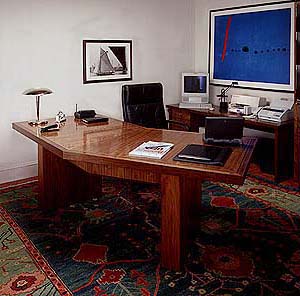|
Finishing
Sand the desktop, modesty panel and pedestals with 120-,
180- and 220-grit sandpaper, dusting off thoroughly between
grits. Be sure to ease all edges and corners. Remove all
sanding dust, then wipe the surfaces with a tack cloth.
In order to achieve a glass-smooth finish on the desktop,
we used a paste filler on the top to fill the open grain of
the walnut. These open pores are not a problem on the
vertical surfaces, but on a horizontal surface, they would
catch the light and be a distraction from the veneer
pattern.
We used Behlen's Pore-O-Pac paste wood filler in Van Dyke
Brown. Spread the filler across the grain of the top with a
brush or rubber squeegee. Then, lightly reapply the filler
with the grain. When the filler takes on a dull appearance,
use a plastic scraper to remove the excess, and vigorously
wipe the surface with burlap cloths to remove any remaining
filler. Let the top dry overnight to allow any solvent to
evaporate.
To provide a tough, yet attractive, finish for the desk, we
used three coats of Behlen's Rockhard Table Top Varnish.
Thin the first coat approximately 20% with the appropriate
reducer and use a quality bristle brush to apply the finish.
Allow the finish to dry at least 12 hours, then sand lightly
with 400-grit paper and dust off thoroughly. Allow the
second coat to dry overnight, then lightly sand before
flowing on the final coat.
While you wait for the finish to dry between coats, you can
cut, bore and countersink the maple feet for the pedestals.
Sand the edges smooth, then use black enamel paint to finish
the feet. Apply two or three coats as required for a good
finish. When the paint and varnish are dry, screw the feet
to the bottom of the pedestals.
To achieve a smooth, satin finish, you should rub out the
varnish, especially on the desktop. Since this varnish is
extremely hard, it should be rubbed and polished within 20
hours of applying the last coat. First, sand the top with
600-grit waterproof paper, using paraffin oil as a
lubricant. When all dust particles and uneven spots are
leveled, wipe the surface with a clean cloth and use No.
0000 steel wool to burnish the surface to an even satin
glow. Polish the top with a soft cloth.
Join the modesty panel to the two pedestals. Use 3/8 X
2-1/2-in. hexhead bolts with washers to connect the parts.
Then install screws through the subtop into the pedestal
sides. Position the desktop over the base and fasten it with
2-in. No. 8 screws. |

